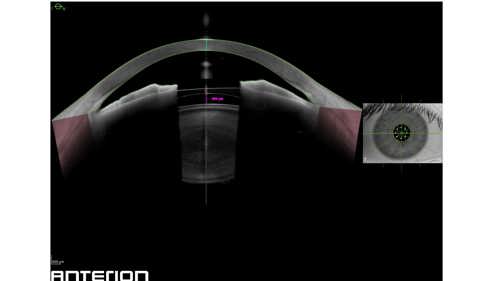Cataract, Refractive, Refractive Surgery, Cataract and Refractive Articles
Refractive Surgery with the Modern Posterior Chamber Phakic IOL
Implant offers many attributes and good outcomes with attention to preoperative, intraoperative, and postoperative care.

Cheryl Guttman Krader
Published: Friday, November 1, 2024
“ Achieving success and happy patients requires excellence at every stage. “
The posterior chamber phakic IOL, EVO/EVO+ Visian Implantable Collamer Lens (ICL), can treat a wide range of myopia/myopic astigmatism, has proven long-term safety and effectiveness, and results in high patient satisfaction. Furthermore, surgeons adopting this option for refractive correction will find screening for appropriate patients easier than screening for excimer laser vision correction and no difficulty in the implantation procedure.
“However, achieving success and happy patients requires excellence at every stage—from planning to postoperative evaluation,” said Robert E Ang MD.
He offered ‘tips and tricks’ for ICL surgery to maximise safety and effectiveness. The recommendations for best practices come from a consensus document, “Building Proficiency with Phakic IOLs,” developed by an international group of 11 refractive surgeons.1
The group unanimously agreed maximising outcomes requires accurate refractive power calculation, pointing to accurate manifest refraction as the most important parameter for achieving success. Accurate size calculation is another critical factor affecting the outcome, but there was considerable variation among the group members in approaches to sizing, technology used for obtaining measurements, and interpretation of the findings.

“There is no single approach that appears to work best, and most surgeons who are experienced with the ICL are comfortable with the method they are using,” Dr Ang said. “However, we are now studying sizing methods with the aim of being able to teach younger-generation surgeons more efficient techniques.”
The ability to measure vault (i.e., the distance between the ICL and the anterior lens surface) is also a key factor for maximising outcomes because an appropriate vault is critical for avoiding postoperative complications, Dr Ang said.
“The risk of anterior subcapsular cataracts increases if the vault is too low, while a very high vault can lead to elevated IOP and angle closure,” he explained, adding that surgeons should be aware there is a tendency for the vault to decrease over time.
Discussing the implant procedure, Dr Ang emphasised two issues: achieving full pupil dilation and thoroughly flushing viscoelastic from the anterior chamber at the close of the case.
“If the eye is only partially dilated, surgeons will have a hard time tucking in the plates of the ICL,” he explained. “With retained viscoelastic, the risk for a postoperative IOP spike is increased.”
Regarding postoperative care, Dr Ang said patients at his clinic are kept for one to two hours after surgery for IOP monitoring to ensure IOP stays below 15 mmHg. If IOP is elevated, he repeats flushing of the anterior chamber, or the eye can be ‘burped.’
Then, in the first few postoperative days, patients are asked to return to check for inflammation, IOP control, and vault.
“Early intervention for these issues is important for having happy patients. Checking for elevated IOP and inflammation allows timely management of those problems,” Dr Ang advised. “And, if the ICL needs to be exchanged because the vault is too high or too low, the surgery may be easier to accomplish earlier than later.”
Dr Ang spoke at the 2024 ESCRS Congress in Barcelona.
Robert E Ang MD is Head of Cornea and Refractive Surgery Services at the Asian Eye Institute in Makati City, Philippines. angbobby@hotmail.com
- Cake 21 supplement. “Building Proficiency with Phakic IOLs,” February 2024. https://issuu.com/mediamice/docs/ cake_21_supplement_building_proficiency_with_phaki.